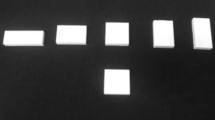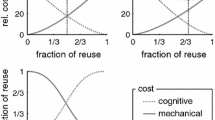Abstract
Almost two decades ago, sequential effects of human grasping behaviour were described for the first time: In a sequential task, participants persisted in using the previous grasp type. According to the plan-modification hypothesis, such sequential effects reduce the movement planning costs and occur within a limited range of indifference. In the current study, we asked whether the anticipated mechanical costs of a movement would compete with the movement planning costs and, thus, reduce the magnitude of the sequential effect. To this end, participants were tested in a sequential, perceptual-motor task (opening a column of drawers), which offered a continuous range of posture solutions for each trial. In a pre-/post-test design, the magnitude of the sequential effect was measured before and after a manipulation phase with increased mechanical costs. Participants displayed a sequential effect for the majority of drawers in the pre-test, which was significantly reduced in the post-test. This finding indicates that each executed movement is a weighted function of both its cognitive and mechanical costs. The result also implies that sequential effects do not result solely from dynamical properties of the motor system, but instead reflect computational features of the movement selection process.






Similar content being viewed by others
References
Chapman KM, Weiss DJ, Rosenbaum DA (2010) Evolutionary roots of motor planning: the end-state comfort effect in lemurs. J Comp Psychol 124(2):229–232
Diedrichsen J, White O, Newman D, Lally N (2010) Use-dependent and error-based learning of motor behaviors. J Neurosci 30(15):5159–5166
Grafton ST, Fadiga L, Arbib MA, Rizzolatti G (1997) Premotor cortex activation during observation and naming of familiar tools. NeuroImage 6(4):231–236
Grèzes J, Decety J (2002) Does visual perception of object afford action? Evidence from a neuroimaging study. Neuropsychologia 40(2):212–222
Hughes CML, Reißig P, Seegelke C (2011) Motor planning and execution in left- and right-handed individuals during a bimanual grasping and placing task. Acta Psychol 138(1):111–118
Jax SA, Rosenbaum DA (2007) Hand path priming in manual obstacle avoidance: evidence that the dorsal stream does not only control visually guided actions in real time. J Exp Psychol Hum Percept Perform 33(2):425–441
Jordan MI, Wolpert DM (1999) Computational motor control. In: Gazzaniga M (ed) The cognitive neurosciences. MIT Press, Cambridge
Kelso JAS, Buchanan JJ, Murata T (1994) Multifunctionality and switching in the coordination dynamics of reaching and grasping. Hum Mov Sci 13(1):63–94
Matsumoto M, Nishimura T (1998) Mersenne twister: a 623-dimensionally equidistributed uniform pseudo-random number generator. ACM Trans Model Comput Simul 8(1):3–30
Mayergoyz ID (1991) Mathematical models of hysteresis. Springer-Verlag, New York
Meulenbroek RGJ, Rosenbaum DA, Thomassen AJWM, Schomaker LRB (1993) Limb-segment selection in drawing behavior. Q J Exp Psychol A 46(2):273–299
Oldfield RC (1971) The assessment and analysis of handedness: the Edinburgh inventory. Neuropsychologica 9:97–113
Rosenbaum DA, Jorgensen MJ (1992) Planning macroscopic aspects of manual control. Hum Mov Sci 11(1–2):61–69
Rosenbaum DA, Marchak F, Barnes HJ, Vaughan J, Slotta JD, Jorgensen MJ (1990) Constraints for action selection: overhand versus underhand grips. In: Jeannerod M (ed) Attention and performance, vol 13. Lawrence Erlbaum Associates Inc, Hillsdale, pp 321–342
Rosenbaum DA, Cohen RG, Meulenbroek RGJ, Vaughan J (2006a) Plans for grasping objects. In: Latash ML, Lestienne F (eds) Motor control and learning. Springer-Verlag, New York, pp 9–25
Rosenbaum DA, Halloran ES, Cohen RG (2006b) Grasping movement plans. Psychon Bull Rev 13(5):918–922
Rosenbaum DA, Cohen RG, Jax SA, Weiss DJ, van der Wel RPRD (2007) The problem of serial order in behavior: Lashley’s legacy. Hum Mov Sci 26(4):525–554
Rosenbaum DA, Chapman KM, Weigelt M, Weiss DJ, van der Wel R (2012) Cognition, action, and object manipulation. Psychol Bull 138(5):924–946
Rossetti Y, Meckler C, Prablanc C (1994) Is there an optimal arm posture? Deterioration of finger localization precision and comfort sensation in extreme arm-joint postures. Exp Brain Res 99(1):131–136
Schütz C, Weigelt M, Odekerken D, Klein-Soetebier T, Schack T (2011) Motor control strategies in a continuous task space. Mot Control 15(3):321–341
Seegelke C, Hughes CML, Schack T (2011) An investigation into manual asymmetries in grasp behavior and kinematics during an object manipulation task. Exp Brain Res 215(1):65–75
Short MW, Cauraugh JH (1997) Planning macroscopic aspects of manual control: end-state comfort and point-of-change effects. Acta Psychol 96(1–2):133–147
Short MW, Cauraugh JH (1999) Precision hypothesis and the end-state comfort effect. Acta Psychol 100(3):243–252
Stöckel T, Hughes CL, Schack T (2012) Representation of grasp postures and anticipatory motor planning in children. Psychol Res 76(6):768–776
Thibaut J-P, Toussaint L (2010) Developing motor planning over ages. J Exp Child Psychol 105(1–2):116–129
Tucker M, Ellis R (1998) On the relations between seen objects and components of potential actions. J Exp Psychol Hum Percept Perform 24(3):830–846
van der Wel RPRD, Rosenbaum DA (2010) Bimanual grasp planning reflects changing rather than fixed constraint dominance. Exp Brain Res 205(3):351–362
van der Wel RPRD, Fleckenstein RM, Jax SA, Rosenbaum DA (2007) Hand path priming in manual obstacle avoidance: evidence for abstract spatiotemporal forms in human motor control. J Exp Psychol Hum Percept Perform 33(5):1117–1126
Weigelt M, Schack T (2010) The development of end-state comfort planning in preschool children. Exp Psychol 57(6):476–482
Weigelt M, Kunde W, Prinz W (2006) End-state comfort in bimanual object manipulation. Exp Psychol 53(2):143–148
Weigelt M, Cohen RG, Rosenbaum DA (2007) Returning home: location memory versus posture memory in object manipulation. Exp Brain Res 179(2):191–198
Weigelt M, Rosenbaum DA, Hülshorst S, Schack T (2009) Moving and memorizing: motor planning modulates the recency effect in serial and free recall. Acta Psychol 132:68–79
Weiss DJ, Wark JD (2009) Hysteresis effects in a motor task with cotton-top tamarins (Sanguinus oedipus). J Exp Psychol Anim Behav Process 35(3):427–433
Weiss DJ, Wark JD, Rosenbaum DA (2007) Monkey see, monkey plan, monkey do. The end-state comfort effect in cotton-top tamarins (Sanguinus oedipus). Psychol Sci 18(12):1063–1068
Author information
Authors and Affiliations
Corresponding author
Rights and permissions
About this article
Cite this article
Schütz, C., Schack, T. Influence of mechanical load on sequential effects. Exp Brain Res 228, 445–455 (2013). https://doi.org/10.1007/s00221-013-3576-3
Received:
Accepted:
Published:
Issue Date:
DOI: https://doi.org/10.1007/s00221-013-3576-3




